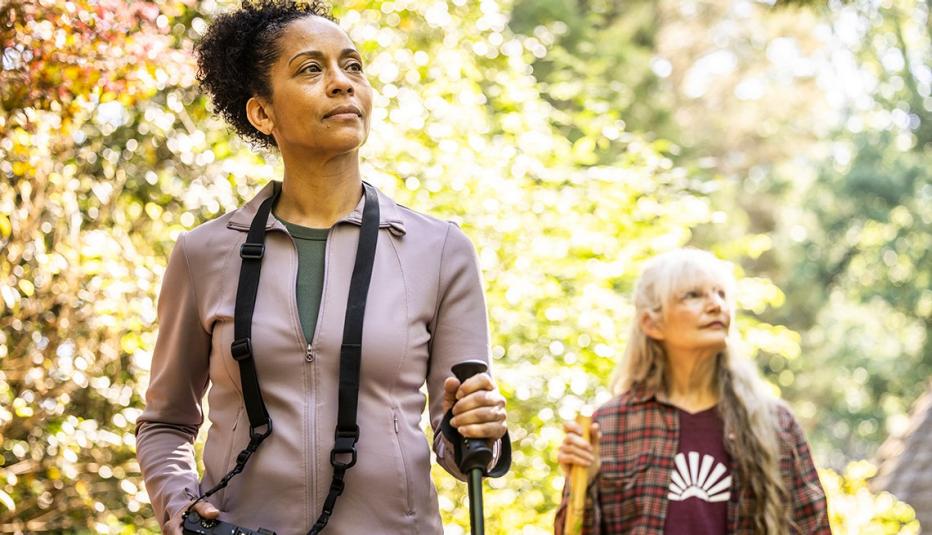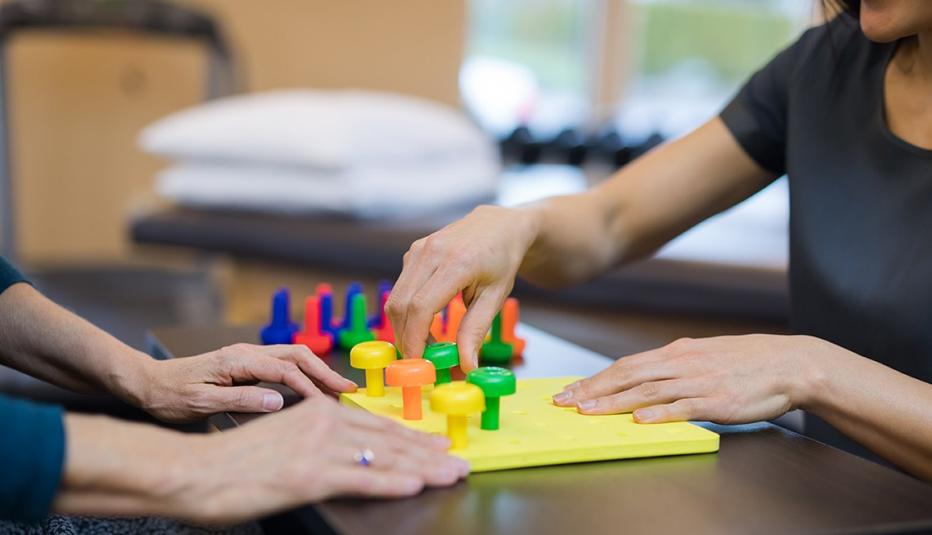AARP Hearing Center


Even though the COVID-19 vaccine has been available to most adults for more than six months, COVID remains a persistent and dangerous problem. As of October 8, approximately 76% of people age 12 and older have received at least one dose of a COVID-19 vaccine and 66% are fully vaccinated. However, vaccination rates vary significantly by state. Indeed, 29 states have a vaccination rate below the national average. Alarmingly, in 15 states fewer than 50% of eligible people are vaccinated. Now, the Delta variant, a more transmissible mutation of COVID-19, plagues the country, pushing the number of new cases and deaths over the summer back up to levels not seen since the beginning of the year.
Telehealth is an effective way, particularly for more vulnerable communities, to access physical and mental health care comfortably and safely. And yet, despite its many benefits, telehealth is underutilized, particularly among older Americans.
Telehealth, also known as telemedicine, enables doctors to provide care to patients without being in the same location. Patients can connect with their physicians over the phone, via text message, or on a video chat. Telehealth has many benefits. It allows patients to maintain social distancing and reduce their potential exposure to COVID-19. It can reduce wait times to meet with physicians, and it can increase the number of specialists available for consultation. Additionally, telehealth can be effective at prescription management, routine check-ups, and counseling. That said, telehealth isn’t right for every patient or every situation. It is critical to talk with your doctor to decide if telemedicine is suitable for you and your medical needs.
Telehealth Use Increased During COVID-19 Pandemic
With hospitals and medical facilities stretched beyond their capacity, through months of lockdowns, and facing the ongoing threat of contracting COVID-19, many Americans turned to telehealth for their physical and mental health care needs. In fact, telehealth use increased dramatically during the pandemic. Adults age 46 and older had the greatest increase in health care visits via telemedicine.
Although statistics show that telehealth use by older adults during the pandemic increased substantially, these data nevertheless obscure meaningful differences in telehealth use among adults.
AARP’s Vital Voices research provides a clearer picture of how COVID-19 has affected adults’ health care decisions by age, race, gender, and LGBTQ status. Vital Voices is a representative survey of adults 45 and older on a wide range of topics such as health care, work, finances, retirement, and caregiving.
As shown in the chart below, telehealth is used less frequently among older Americans. Indeed, adults 65 and older are 36% less likely than those ages 45–49 to have used telemedicine during the pandemic.
Even though evidence in the study published in the American Journal of Preventative Medicine suggests that telehealth use during the pandemic increased the most among adults 46 and older, these data from the Vital Voices survey reveal that the oldest Americans — those at the greatest risk of COVID-19 infection — were less likely to have used telemedicine in 2020. Understanding how telehealth use differs by age is essential for a number of reasons. For example, a person’s health care needs and risks differ as they age. The barriers a person faces accessing health care may change as they get older. Comfort with and access to high-speed broadband internet for telemedicine, for instance, diminishes slightly among older adults who participated in the Vital Voices survey (ages 45–49, 82%; ages 50–64, 78%; age 65-plus, 77%). Given these and other differences, strategies to make telehealth more accessible and appealing will likely need to be adapted for people as they age and their needs and preferences change.
Telehealth Use Varies by Race
In addition to examining how telehealth use differs by age, we need to examine how telehealth use differs by race. The COVID-19 pandemic has disproportionately affected communities of color. Black and Latino people are significantly more likely to be infected by COVID-19. They are also more likely to succumb to the disease. Insufficient and inequitable access to high-quality health care is a key factor contributing to the higher COVID-19 infection rates among communities of color.
Telehealth, although alone not an answer to systemic discrimination, may be an important piece of a larger strategy to help address disparities in health care. Given that it circumvents typical barriers to health care, Black, Latino, and Asian respondents to the Vital Voices survey reported greater rates of telehealth use than the rate for all respondents. (Throughout this report, Asian includes those who identify as Pacific Islanders.) As shown in the chart below, the lone exception is for Latinos ages 45–49.
Despite higher usage rates, the percentage of respondents who reported using telehealth during 2020 decreased as age increased. That said, the drop in telehealth use was lower among Black and Asian respondents than among the survey participants overall. And there is an even larger difference: Latino respondents were more likely to report using telemedicine the older they are.
In most instances, people of color are more likely to use telemedicine than other respondents. They also have fewer significant drop-offs among higher age groups. As such, telehealth may be an effective strategy to provide care to those communities who are disproportionately at risk of COVID-19 and who also often lack equitable access to health care.
Telehealth Use Varies by Gender and LGBTQ Status
As with age and race, the use of telehealth technology varies by gender and by those who identify as LGTBQ. Analyzing the Vital Voices survey data, we found that women are more likely than men to participate in telehealth. However, as shown in the chart below, that pattern varies somewhat by race. Latino women are far more likely than Latino men to use telemedicine. Indeed, Latino women are 25% more likely to use telehealth than Latino men. However, that pattern is flipped for Black and Asian respondents. Black and Asian men are slightly more likely than Black and Asian women to participate in telehealth.
Mental health challenges are disproportionately high among the LGBTQ community. The COVID-19 pandemic has exacerbated those challenges, leading many to seek out mental health care — including via telehealth — at higher rates than non-LGBTQ individuals. Among all respondents to the Vital Voices survey, those who identify as LGBTQ reported, by a wide margin, the highest rates of telehealth use (see chart below). Among those 65 years and older, people who identify as LGBTQ were more than twice as likely to use telehealth as participants in the survey overall. Additionally, there is not a meaningful change in telehealth use among older LGBTQ respondents. In fact, people 45–49 and those 65 and up reported about the same rates of telehealth use.
The general pattern of women using telehealth at higher rates than men continues among adults who identify as LGBTQ. Fifty-four percent of LGBTQ women reported using telehealth, compared with 45% of LGBTQ men. In other words, LGBTQ women are more likely than men to use telemedicine.
Internet Access and Telehealth
Although it is not the sole method of using telemedicine, patients commonly connect with their physicians over the internet. Therefore, access to high-speed broadband is a critical component of telehealth access. The good news is that a majority of respondents, across all ages, reported that it was very or somewhat easy to meet with their health care providers through the internet. Indeed, more than 80% of respondents ages 45–49 said it was very easy, and 77% of those 65 or older agreed.
While it is encouraging that most adults report that accessing telehealth through the internet was easy, the fact remains that nearly 20% of all respondents said they found accessing telemedicine services on the internet difficult. Across the country, that translates to millions of people who had undue difficulty using telemedicine. The figures are fairly consistent by race: 21% of White as well as 21% of Black respondents reported that it was somewhat or very hard to use the internet for telehealth. However, Latino respondents reported little difficulty using the internet to access telehealth. Only 5% said that they had a somewhat or very difficult time.
Access to the internet is important not only because it facilitates effective use of telehealth. The internet is also important for employment and maintaining connections with family and friends, particularly during a national public health crisis. We will explore how access to and experiences with broadband varies among respondents to the Vital Voices survey in a future post.
Conclusion
During the COVID-19 pandemic, the use of telehealth increased dramatically. It offers a safe, convenient, and effective way for many people to receive physical and mental health care. However, the increase in telehealth use varies by age, gender, and race. The differences in use could be motivated by a number of different factors, such as insufficient awareness, inequitable access, or other meaningful barriers to remote health care. For example, by delving more deeply into the populations that use telehealth, we found that older Americans, those 65 and older, are less likely to use telehealth than adults ages 45–49 or 50–64, despite being at an increased risk of contracting COVID-19.
The differences in use also suggest that we will need to deploy multiple strategies tailored to different populations to ensure as many people as possible can, as appropriate, incorporate telemedicine into their approach to health care. As the pandemic continues, and even once we get it to a more manageable level, health care providers and policy makers should develop targeted strategies to increase access and eliminate barriers to using the technology and ensure that all people, regardless of age, gender, race, or LGBTQ status can take advantage of telehealth.
For more information about this article, please contact Cassandra Cantave at ccantave@aarp.org. Unless otherwise indicated, this article is based on survey data from the Vital Voices 2020 National Chartbook, part of AARP's Vital Voices Research.



































































